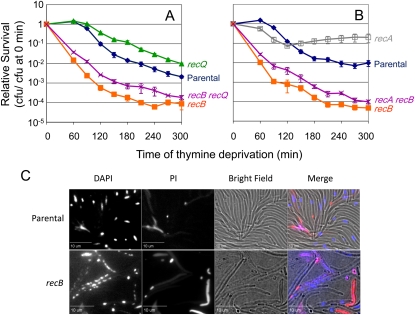Figure 6 .
RecBCD resists a RecA-, SOS-, and RecQ-independent TLD pathway. (A) Much of the RecB role in TLD survival is independent of RecQ. ΔrecB ΔrecQ (SMR11214; purple X) cells are slightly less sensitive to TLD than ΔrecB cells (SMR10665; solid orange square; P < 0.05). ΔrecQ (SMR10681; solid green triangle), parental (AB2497; solid blue diamond). (B) Neither SOS nor homologous recombination creates the problem that RecB+ action resists in that RecB is required for TLD survival in the absence of RecA. ΔrecA ΔrecB cells (SMR10671; purple X) are slightly less sensitive to TLD than ΔrecB cells (SMR10665; solid orange square; P < 0.05). ΔrecA (SMR10670; open gray square), parental (AB2497; solid blue diamond). Means ±SEM of three independent experiments. (C) Representative pictures of parental (AB2497) and ΔrecB cells (SMR10665) after 12 hr of TLD. Note that although many cells or the Rec+ parent are visible in brightfield, few display compact DAPI-stained nucleoids, whereas nearly all of the recB cells visible in brightfield show strings of small fragmented-looking nucleoids, which were not visible before thymine deprivation. In the merged image, DAPI (DNA stain) is blue and propidium iodide (PI, stain for dead cells) is red.

